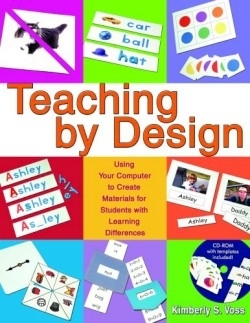Teaching by Design
Using Your Computer to Create Materials for Students with Learning Differences
- 2005 INDIES Finalist
- Finalist, Education (Adult Nonfiction)
Wanting to help teach her daughter with multiple impairments, the author developed customized educational materials, examples of what others could do to educate children with disabilities. The result is this book, which provides readers with the information they need to construct modified learning materials using computer software, to help parents and educators remove learning barriers.
Teaching By Design is the outgrowth of Voss’s other works, including a software program she published in 1996 called See, Hear, and Say. Voss has also conducted workshops, at national and international levels, concerning the use of technology to educate disabled children. With great skill and detail, she has written this book so that a person who has never sat in front of a computer can get the job done. There’s no need to be frightened by any technical tasks, because Voss carefully displays how to create supplies like interactive flashcards to assist children with spelling, communication, mathematical, and visual tasks.
She discusses important information like the relationship between text size and peripheral vision: “For people who have lost some peripheral vision, text on a line can begin to run outside their visual field as it is enlarged, making it more difficult to be seen.” At times, the reader might feel visually overloaded, due to Voss’s photographic examples and demonstrations. At those points, it becomes apparent that the writer has a photographic bias; however, she clearly understands the power and importance of visuals, and how to use them effectively.
For each creative undertaking, Voss identifies the skills that the project is designed to aid the student with, describes the project’s level of difficulty, and provides a list of materials needed to complete it. The directions are straightforward and easy to comprehend. One project explains how to use flashcards to teach students how to accomplish assignments like memorizing their daily schedule, by printing the time on one side of the card and the task to be completed on the other side. In another, sophisticated, example, flashcards are described for use in teaching sign language.
Voss even makes a quick mention of copyright laws, so readers can avoid committing copyright infringement when creating the materials. At the end of the text, Voss lists resources that can be used to locate graphics for both Macintosh and Windows users, as well as places to purchase craft supplies.
The focus of Voss’s text is more on making the educational materials meaningful, rather than on what a child cannot do—and that is one of this book’s great strengths. Teaching By Design is an excellent resource for teachers, parents, tutors, and anyone interested in modified instruction materials for students with learning differences.
Reviewed by
Kisha Jackson
Disclosure: This article is not an endorsement, but a review. The publisher of this book provided free copies of the book to have their book reviewed by a professional reviewer. No fee was paid by the publisher for this review. Foreword Reviews only recommends books that we love. Foreword Magazine, Inc. is disclosing this in accordance with the Federal Trade Commission’s 16 CFR, Part 255.

